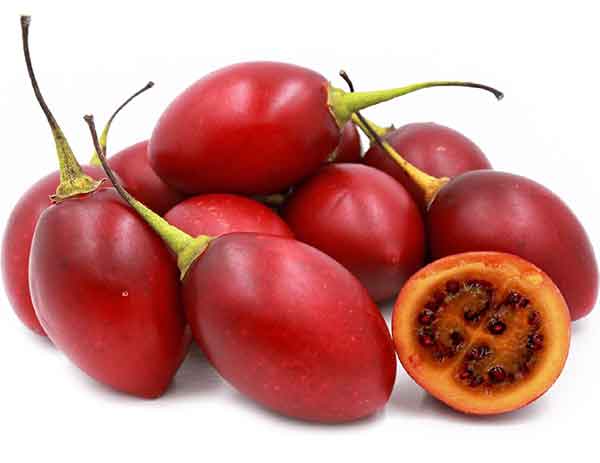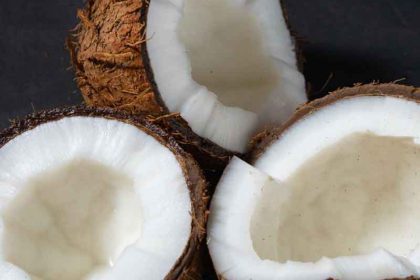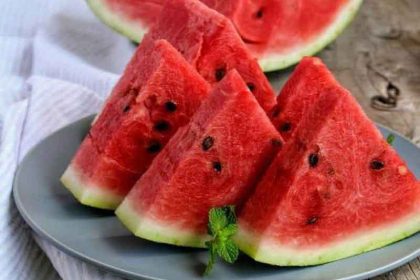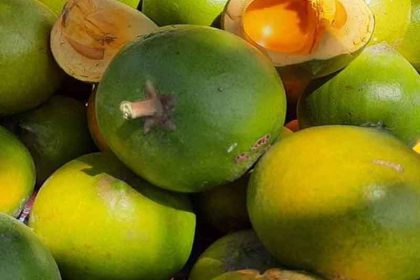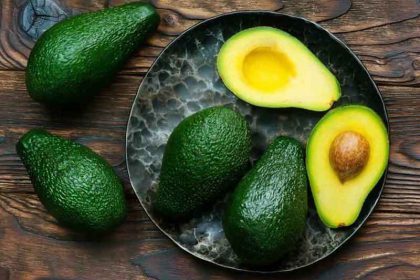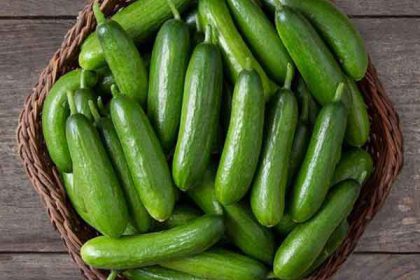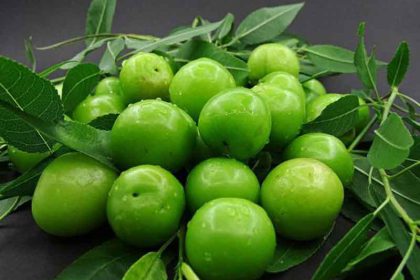Tamarillo benefits and nutrition for skin and diabetes and gout
Tamarillo
Tamarillo benefits and nutrition for skin and diabetes and gout On Nicholi site. We hope this article will be of interest to you.
The text provides information about the benefits, side effects, uses, recipes, and skin benefits of tamarillo, also known as the tree tomato. Tamarillos are rich in nutrients, antioxidants, and fiber, making them beneficial for heart health, digestion, weight management, eye health, and skin health. The text also mentions that while tamarillo is generally safe to consume, some individuals may experience allergic reactions, digestive discomfort, or interactions with medications. It suggests using tamarillo in various ways, such as fresh consumption, juices, jams, sauces, salsas, baked goods, and dressings. Additionally, it provides recipes for tamarillo salsa, tamarillo, and goat cheese salad, and tamarillo tart. The text addresses concerns regarding tamarillo’s suitability for gout and clarifies that the skin of tamarillo is not poisonous but may be unpalatable to some individuals. Lastly, it discusses the potential skin benefits of tamarillo due to its antioxidant content and ability to support collagen production, hydration, and skin cell renewal. The text provides information about tamarillo, including its nutrition facts, how to eat it, pronunciation, and various recipes using tamarillo. Tamarillo is a tropical fruit with a tangy and slightly sweet flavor. It can be eaten raw, added to salads, used in chutneys, jams, and sauces, and incorporated into baked goods. The text includes recipes for tamarillo chutney, curry, raita, chicken, jam, chili jam, and two types of tamarillo sauce. It also offers guidance on selecting ripe tamarillos and provides a pronunciation guide for the word “tamarillo.”
Tamarillo benefits
Tamarillo, also known as the tree tomato, is a fruit native to South America that is known for its unique flavor and various health benefits. Here are some potential benefits of consuming tamarillo:
Rich in nutrients: Tamarillos are a good source of essential vitamins and minerals. They contain high levels of vitamin A, vitamin C, vitamin E, and potassium. Vitamin A is beneficial for vision, vitamin C supports immune function, vitamin E is an antioxidant that protects cells from damage, and potassium is essential for heart health and proper muscle function.
Antioxidant properties: Tamarillos are rich in antioxidants, such as carotenoids and flavonoids. These compounds help neutralize harmful free radicals in the body, reducing the risk of chronic diseases and supporting overall health.
Heart health: Tamarillos are low in sodium and high in potassium, which can help regulate blood pressure levels. The potassium content in tamarillos promotes proper heart function and can contribute to a healthy cardiovascular system.
Digestive health: Tamarillos are a good source of dietary fiber, which is essential for maintaining a healthy digestive system. Adequate fiber intake can help prevent constipation, promote regular bowel movements, and support a healthy gut.
Weight management: Tamarillos are low in calories and fat while being high in fiber. Including tamarillos in your diet can help you feel full for longer, reducing the chances of overeating and aiding in weight management.
Eye health: Tamarillos are rich in vitamin A, which is crucial for maintaining healthy eyesight. Vitamin A plays a role in supporting night vision and reducing the risk of age-related macular degeneration and other eye conditions.
Skin health: The antioxidants present in tamarillos can help protect the skin from damage caused by free radicals. Additionally, the high vitamin C content supports collagen production, which is essential for maintaining healthy skin and reducing the signs of aging.
It’s important to note that while tamarillo can offer potential health benefits, individual results may vary, and it should be consumed as part of a balanced diet. If you have any specific health concerns, it’s always best to consult with a healthcare professional or nutritionist for personalized advice.
Tamarillo side effects
Tamarillo is generally considered safe for consumption, and there are no significant known side effects associated with its consumption. However, it’s important to note that individual responses to foods can vary, and some people may have specific sensitivities or allergies that could lead to adverse reactions. Here are a few considerations regarding tamarillo consumption:
Allergic reactions: Some individuals may be allergic to tamarillo or other fruits in the Solanaceae family, which includes tomatoes and eggplants. Allergic reactions may include symptoms such as itching, swelling, hives, or difficulty breathing. If you have known allergies to related fruits or experience any allergic symptoms after consuming tamarillo, it’s advisable to seek medical attention.
Oxalate content: Tamarillo contains moderate levels of oxalates, naturally occurring compounds found in many fruits, vegetables, and other foods. In some individuals, excessive consumption of oxalate-rich foods can contribute to the formation of kidney stones or exacerbate existing kidney stone conditions. If you have a history of kidney stones or are prone to them, it’s advisable to moderate your intake of oxalate-containing foods, including tamarillo.
Digestive discomfort: In rare cases, some individuals may experience digestive issues such as stomach upset, diarrhea, or bloating after consuming tamarillo. This may be due to individual sensitivities or intolerances. If you experience any digestive discomfort, it’s best to reduce or eliminate tamarillo from your diet and consult with a healthcare professional if the symptoms persist.
Interactions with medications: As with any food, tamarillo may interact with certain medications. For example, tamarillo’s vitamin K content may interfere with blood-thinning medications such as warfarin. If you are taking any medications, it’s advisable to consult with your healthcare provider or pharmacist to determine if there are any potential interactions between tamarillo and your medications.
Tamarillo uses
Tamarillo, or tree tomato, can be used in various ways in cooking and other applications. Here are some common uses for tamarillo:
Fresh consumption: Tamarillos can be eaten fresh by cutting them in half and scooping out the flesh with a spoon. The flesh has a tangy and slightly sweet flavor that can be enjoyed on its own or added to fruit salads.
Juices and smoothies: Tamarillos can be juiced or blended into smoothies to create refreshing and nutritious beverages. You can combine tamarillo with other fruits or add it to vegetable juices for a unique flavor profile.
Jams and preserves: The tangy flavor of tamarillo makes it an excellent ingredient for making jams, jellies, and preserves. The fruit can be cooked down with sugar and other ingredients to create a spreadable condiment that can be enjoyed on toast, crackers, or used in baking.
Sauces and chutneys: Tamarillos can be cooked and processed into sauces and chutneys that can accompany various dishes. The tangy and slightly sweet flavor of tamarillo makes it a great addition to savory sauces and chutneys that pair well with meats, cheeses, and bread.
Salsas and salads: Tamarillos can be diced or sliced and used in salsas and salads to add a burst of flavor. They can be combined with other fruits, vegetables, and herbs to create refreshing and vibrant side dishes.
Baked goods: Tamarillos can be used in baking to add a unique flavor to cakes, muffins, bread, and tarts. They can be used in their fresh form, or you can cook them down and use them as a filling or topping for pastries.
Condiments and dressings: Tamarillo can be processed into sauces, dressings, and vinaigrettes that can be drizzled over salads, roasted vegetables, or grilled meats for added flavor.
It’s worth noting that tamarillo has a distinct flavor that may not appeal to everyone. It is often described as tangy, acidic, and slightly sweet. Experimenting with different recipes and combinations can help you discover the best way to enjoy tamarillo based on your taste preferences.
Tamarillo recipes
Here are a few tamarillo recipes you can try:
- Tamarillo Salsa: Ingredients:
- 2 tamarillos, diced
- 1 small red onion, finely chopped
- 1 jalapeño pepper, seeded and finely chopped
- Juice of 1 lime
- Fresh cilantro, chopped
- Salt and pepper to taste
Instructions: Combine all the ingredients in a bowl and mix well. Allow the flavors to meld together for at least 30 minutes before serving. This salsa goes well with grilled meats, or fish, or as a dip with tortilla chips.
2. Tamarillo and Goat Cheese Salad: Ingredients:
- 2 tamarillos, sliced
- Mixed salad greens
- 1/2 cup crumbled goat cheese
- Handful of toasted walnuts
- Balsamic vinaigrette dressing
Instructions: Arrange the salad greens on a plate. Top with sliced tamarillos, crumbled goat cheese, and toasted walnuts. Drizzle with balsamic vinaigrette dressing or the dressing of your choice. Serve as a light and refreshing salad.
3. Tamarillo Tart: Ingredients:
- 1 sheet of pre-made pie crust or puff pastry
- 4 tamarillos, sliced
- 1/4 cup sugar
- 1 tablespoon flour
- 1 teaspoon vanilla extract
Instructions: Preheat the oven according to the package instructions for the pie crust or puff pastry. Roll out the pastry and transfer it to a tart pan. In a bowl, mix sugar, flour, and vanilla extract. Arrange the tamarillo slices on the pastry and sprinkle the sugar mixture evenly over the top. Bake in the preheated oven for about 20-25 minutes or until the pastry is golden and the tamarillos are tender. Serve warm or at room temperature.
These are just a few examples of how you can incorporate tamarillo into your recipes. Feel free to modify and experiment with these ideas to suit your taste preferences.
Is tamarillo good for gout?
While tamarillo is generally considered a healthy fruit, it is important to note that it is moderately high in oxalates. Oxalates are naturally occurring substances found in many foods, and they can contribute to the formation of kidney stones in some individuals. For people with gout, it is important to manage their intake of purine-rich foods and substances that can increase uric acid levels in the body. Gout is a type of arthritis caused by the buildup of uric acid crystals in the joints, leading to inflammation and pain. Although tamarillo is not particularly high in purines, its moderate oxalate content may make it advisable for individuals with gout to consume it in moderation. It is recommended for those with gout to work with a healthcare professional or a registered dietitian who can provide personalized guidance on managing their diet and making suitable food choices based on their individual needs and sensitivities.
Is tamarillo skin poisonous?
No, the skin of tamarillo (tree tomato) is not considered poisonous. However, the skin can have a slightly bitter taste and a tougher texture compared to the flesh of the fruit. Many people prefer to remove the skin before consuming tamarillo, especially if they find it unpalatable. If you choose to eat the tamarillo skin, it is recommended to wash the fruit thoroughly to remove any dirt or contaminants that may be present on the skin. Additionally, it’s important to ensure that the tamarillo you consume is ripe and not unripe, as unripe fruits can sometimes contain higher levels of naturally occurring compounds that may cause digestive discomfort. As with any food, individual sensitivities or allergies can vary, so it’s always a good idea to listen to your body and consult with a doctor professional if you have any concerns or experience any adverse reactions after consuming tamarillo or any other food.
Tamarillo fruit benefits for skin
Tamarillo fruit offers several potential benefits for the skin due to its nutrient content and antioxidant properties. Here are some ways in which tamarillo may be beneficial for the skin: Tamarillo is rich in antioxidants, including vitamin C and vitamin E, which help protect the skin from damage caused by free radicals. Free radicals are unstable molecules that can lead to oxidative stress and premature aging of the skin. The antioxidants in tamarillo help neutralize these free radicals, promoting healthier and more youthful-looking skin. Vitamin C is essential for collagen synthesis, a protein that provides structure and elasticity to the skin. Tamarillo’s high vitamin C content supports collagen production, which can contribute to smoother and firmer skin. Adequate collagen levels help reduce the appearance of fine lines and wrinkles. Tamarillo contains a significant amount of water, which can help hydrate the skin from within. Well-hydrated skin appears plumper, healthier, and more radiant. Consuming tamarillo as part of a balanced diet can contribute to overall skin hydration. The vitamins and minerals present in tamarillo, including vitamin A and potassium, can support skin cell turnover and renewal. This can contribute to a more radiant and rejuvenated complexion. Tamarillo’s antioxidant properties can help protect the skin from damage caused by ultraviolet (UV) radiation. While it should not replace sunscreen or other sun protection measures, consuming antioxidant-rich foods like tamarillo may provide an additional layer of defense against UV-induced skin damage. It’s important to note that individual results may vary, and the effects of tamarillo on the skin may not be dramatic or immediate. For optimal skin health, it’s recommended to incorporate a holistic approach that includes a balanced diet, proper hydration, sun protection, regular skincare practices, and overall healthy lifestyle habits.
Tamarillo nutrition facts
Here are the approximate nutrition facts for 100 grams (3.5 ounces) of tamarillo fruit:
Calories: 31
Carbohydrates: 6.5 grams
Fiber: 3.2 grams
Protein: 1.5 grams
Fat: 0.4 grams
Vitamin A: 1624 IU (32% of the daily recommended intake)
Vitamin C: 24.9 mg (42% of the daily recommended intake)
Vitamin E: 1.7 mg (8% of the daily recommended intake)
Potassium: 303 mg
Calcium: 7 mg
Iron: 0.8 mg
Please note that these values are approximate and can vary slightly depending on the size and ripeness of the tamarillo. The fruit is low in calories and fat while providing a good amount of dietary fiber, vitamins A and C, and potassium. It is also a source of other essential nutrients, albeit in smaller amounts.
Tamarillo fruit how to eat
To eat a tamarillo fruit, follow these steps:
Choose a ripe tamarillo: Look for a tamarillo that has vibrant, smooth skin and feels slightly soft when gently pressed. Avoid fruits with blemishes, bruises, or overly wrinkled skin, as these may indicate a lack of freshness.
Wash the fruit: Rinse the tamarillo under cool running water to remove any dirt or debris on the skin. Gently pat it dry with a clean towel.
Cut the fruit in half: Place the tamarillo on a cutting board and use a sharp knife to cut it in half lengthwise, from the stem end to the bottom.
Scoop out the flesh: Once the fruit is halved, you can use a spoon to scoop out the flesh from each half. Run the spoon along the edges, separating the flesh from the skin. The flesh should easily separate from the skin, revealing the juicy interior.
The tamarillo flesh can be eaten as is, or you can slice it further or dice it for various preparations. Tamarillo has a tangy and slightly sweet flavor that can be enjoyed on its own or added to fruit salads, smoothies, sauces, or other culinary creations. If you prefer not to eat the skin, you can discard it after scooping out the flesh. The skin is edible, but it can have a slightly bitter taste and a tougher texture compared to the flesh. Remember to store any leftover tamarillo in the refrigerator in an airtight container for optimal freshness.
Tamarillo pronunciation
The pronunciation of “tamarillo” is tuh-muh-RIL-oh. Each syllable is pronounced as follows:
- “Tuh” rhymes with “duh” or “Muh.”
- “Muh” rhymes with “duh” or “Muh.”
- “RIL” sounds like the word “rill” or “ril.”
- “Oh” rhymes with “go” or “low.”
So, when you put it all together, it sounds like tuh-muh-RIL-oh.
tamarillo recipes Indian
While tamarillo is not commonly used in traditional Indian cuisine, you can still incorporate it into Indian-inspired recipes. Here are a few ideas:
Tamarillo Chutney:
Ingredients:
4 tamarillos, peeled and chopped
1 small onion, finely chopped
2 cloves of garlic, minced
1-inch piece of ginger, grated
2 green chilies, chopped
1 tablespoon oil
1 teaspoon mustard seeds
1 teaspoon cumin seeds
1/2 teaspoon turmeric powder
1/2 teaspoon red chili powder
Salt to taste
Sugar or jaggery (optional, for sweetness)
Instructions:
Heat oil in a pan and add mustard seeds and cumin seeds. Once they start to splutter, add onions, garlic, ginger, and green chilies. Sauté until onions turn translucent. Add tamarillos, turmeric powder, red chili powder, and salt. Cook until the tamarillos soften and turn mushy. If desired, add a little sugar or jaggery for sweetness. Remove from heat and let it cool. Blend the mixture to a smooth consistency. Serve as a condiment with Indian snacks or as a side dish with meals.
Tamarillo Curry:
Ingredients:
4 tamarillos, peeled and chopped
1 onion, finely chopped
2 tomatoes, chopped
2 cloves of garlic, minced
1-inch piece of ginger, grated
1 green chili, chopped
1 teaspoon cumin seeds
1/2 teaspoon turmeric powder
1 teaspoon coriander powder
1/2 teaspoon red chili powder
1/2 teaspoon garam masala
Salt to taste
Fresh coriander leaves for garnish
Oil for cooking
Instructions:
Heat oil in a pan and add cumin seeds. Once they start to splutter, add onions, garlic, ginger, and green chili. Sauté until onions turn golden brown. Add tomatoes and cook until they soften. Add turmeric powder, coriander powder, red chili powder, and salt. Cook the spices for a minute. Add chopped tamarillos and a little water. Cover and simmer until the tamarillos are cooked and the flavors are well combined. Sprinkle garam masala and garnish with fresh coriander leaves. Serve with rice or Indian bread.
Tamarillo Raita:
Ingredients:
2 tamarillos, peeled and chopped
1 cup plain yogurt
1/2 teaspoon cumin powder
1/4 teaspoon black salt (kala Namak)
1/4 teaspoon roasted cumin seeds
Fresh coriander leaves for garnish
Salt to taste
Instructions:
In a bowl, whisk the yogurt until smooth. Add chopped tamarillos, cumin powder, black salt, and salt. Mix well. Garnish with roasted cumin seeds and fresh coriander leaves. Serve as a refreshing side dish with Indian meals.
Tamarillo recipes chicken
Ingredients:
- 4 chicken breasts
- 2 tamarillos, peeled and chopped
- 1 onion, finely chopped
- 2 cloves of garlic, minced
- 1 teaspoon ginger paste
- 1 teaspoon cumin powder
- 1 teaspoon coriander powder
- 1/2 teaspoon turmeric powder
- 1/2 teaspoon red chili powder (adjust to taste)
- Salt to taste
- 2 tablespoons oil
- Fresh coriander leaves for garnish
Instructions:
Season the chicken breasts with salt and set them aside. Heat oil in a pan over medium heat. Add the chopped onion and sauté until golden brown. Add minced garlic and ginger paste. Sauté for a minute until fragrant. Add cumin powder, coriander powder, turmeric powder, and red chili powder. Mix well and cook for a minute to toast the spices. Add the seasoned chicken breasts to the pan and cook until they are browned on all sides. Reduce the heat to low and add the chopped tamarillos. Stir well to coat the chicken with the spices and tamarillo. Cover the pan and simmer for about 15-20 minutes, or until the chicken is cooked through and tender. Stir occasionally and check for the desired consistency of the sauce. If it becomes too thick, you can add a little water. Adjust the seasoning with salt if needed. Garnish with fresh coriander leaves before serving. Serve the tamarillo chicken hot with steamed rice, naan bread, or your favorite side dishes. The tamarillo adds a tangy and slightly sweet flavor to the chicken, creating a unique and delicious dish.
Tamarillo jam
recipe for tamarillo jam:
Ingredients:
- 8 tamarillos, peeled and chopped
- 2 cups granulated sugar
- Juice of 1 lemon
- 1 teaspoon lemon zest
- 1 teaspoon vanilla extract (optional)
Instructions:
Place the chopped tamarillos in a saucepan and add the sugar. Mix well and let it sit for about 1 hour to allow the sugar to draw out the juices from the tamarillos.
Add the lemon juice and lemon zest to the saucepan.
Place the saucepan over medium heat and bring the mixture to a boil, stirring frequently to dissolve the sugar.
Reduce the heat to low and simmer the mixture for about 45 minutes to 1 hour, or until the jam thickens and reaches the desired consistency. Stir occasionally to prevent sticking.
If desired, add the vanilla extract during the last 5 minutes of cooking for additional flavor.
Once the jam has thickened, remove the saucepan from the heat and let it cool slightly.
Transfer the jam to sterilized jars, leaving a bit of headspace at the top.
Seal the jars tightly and let them cool completely before storing them in the refrigerator.
The tamarillo jam can be stored in the refrigerator for up to a month.
Enjoy the homemade tamarillo jam on toast, scones, or as a topping for desserts.
Tamarillo chili jam recipe
Certainly! Here’s a recipe for Tamarillo Chili Jam:
Ingredients:
- 1 kg tamarillos
- 3 red chili peppers (adjust according to your spice preference)
- 4 cloves of garlic
- 1 thumb-sized piece of ginger
- 2 cups granulated sugar
- 1 cup white vinegar
- Juice of 1 lemon
- 1 teaspoon salt
Instructions:
Prepare the tamarillos by scoring a small ‘X’ at the base of each fruit. Place them in a pot of boiling water for 1-2 minutes, then transfer them to a bowl of cold water. This will help loosen the skin. Once the tamarillos have cooled, peel off the skin and discard. Chop the tamarillos into small pieces and set aside. Finely chop the chili peppers, garlic, and ginger. You can remove the seeds from the chili peppers if you prefer less heat. In a large saucepan, combine the chopped tamarillos, chili peppers, garlic, ginger, sugar, vinegar, lemon juice, and salt. Place the saucepan over medium heat and bring the mixture to a gentle simmer, stirring occasionally. Allow the mixture to simmer for about 45-60 minutes, or until it thickens to a jam-like consistency. Stir occasionally to prevent sticking. As the mixture thickens, keep an eye on it and adjust the heat as needed. Be careful as it thickens because it can bubble and splatter. Once the jam has reached the desired consistency, remove the saucepan from the heat and let it cool for a few minutes. Pour the hot jam into sterilized jars and seal them tightly. Allow the jars to cool completely before storing them in the refrigerator. The Tamarillo Chili Jam can be stored in the refrigerator for up to 2-3 weeks.
Tamarillo sauce recipes
Recipe 1: Sweet and Tangy Tamarillo Sauce
Ingredients:
- 6 ripe tamarillos
- 1 small onion, finely chopped
- 2 cloves of garlic, minced
- 1 tablespoon olive oil
- 1/4 cup brown sugar
- 2 tablespoons balsamic vinegar
- 1 teaspoon Worcestershire sauce
- Salt and pepper to taste
Instructions:
Score a small ‘X’ at the base of each tamarillo. Place them in a pot of boiling water for 1-2 minutes, then transfer them to a bowl of cold water. This will help loosen the skin.
Once the tamarillos have cooled, peel off the skin and discard. Chop the tamarillos into small pieces and set aside.
Heat olive oil in a saucepan over medium heat. Add the chopped onion and minced garlic, and sauté until they become translucent and fragrant.
Add the chopped tamarillos to the saucepan and cook for about 5 minutes, stirring occasionally.
Stir in the brown sugar, balsamic vinegar, Worcestershire sauce, salt, and pepper. Mix well to combine all the ingredients.
Reduce the heat to low and let the sauce simmer for about 15-20 minutes, or until it thickens slightly. Stir occasionally.
Remove the saucepan from the heat and let the sauce cool down. Transfer the sauce to a blender or food processor and blend until smooth.
Once blended, strain the sauce through a fine mesh strainer to remove any seeds or pulp.
Pour the tamarillo sauce into a sterilized jar or bottle and store it in the refrigerator. The sauce will keep for up to 1-2 weeks.
Recipe 2: Spicy Tamarillo Sauce
Ingredients:
- 6 ripe tamarillos
- 1 small onion, finely chopped
- 2 cloves of garlic, minced
- 2 red chili peppers, finely chopped
- 1 tablespoon olive oil
- 2 tablespoons tomato paste
- 1 tablespoon brown sugar
- 1/2 cup water
- Salt to taste
Instructions:
Follow steps 1 and 2 from the previous recipe to peel and chop the tamarillos.
Heat olive oil in a saucepan over medium heat. Add the chopped onion, minced garlic, and chili peppers. Sauté until the onion becomes translucent and the chili peppers are fragrant.
Add the chopped tamarillos to the saucepan and cook for about 5 minutes, stirring occasionally.
Stir in the tomato paste, brown sugar, water, and salt. Mix well to combine all the ingredients.
Reduce the heat to low and let the sauce simmer for about 20-25 minutes, or until it thickens to a sauce consistency. Stir occasionally.
Remove the saucepan from the heat and let the sauce cool down slightly.
Transfer the sauce to a blender or food processor and blend until smooth.
Once blended, pour the tamarillo sauce into a sterilized jar or bottle. Allow it to cool completely before storing it in the refrigerator.
Tamarillo fruit
Tamarillo, also known as the tree tomato, is a tropical fruit native to South America. It belongs to the Solanaceae family, which includes tomatoes, potatoes, and eggplants. Tamarillos have an oval shape and come in various colors, including red, yellow, and orange. The skin is smooth and thin, and the flesh is juicy and firm.
The flavor of tamarillo is often described as tangy and slightly sweet, with a hint of acidity. The taste can vary depending on the variety and ripeness of the fruit. Ripe tamarillos are typically sweeter and have a more intense flavor.
Tamarillos can be eaten raw or used in various culinary applications. Here are some ways to enjoy tamarillo fruit:
Raw: Simply cut the tamarillo in half lengthwise and scoop out the flesh with a spoon. You can eat it as is or sprinkle some sugar or honey for added sweetness.
Salads: Add sliced or diced tamarillo to fruit salads or green salads for a tangy and refreshing element.
Salsas and Chutneys: Tamarillos can be used to make delicious salsas and chutneys. Combine chopped tamarillo with onions, cilantro, lime juice, and spices for a flavorful condiment.
Jams and Preserves: Tamarillos can be cooked down with sugar and spices to make jams, jellies, and preserves. These can be enjoyed on toast, and pancakes, or used as a topping for desserts.
Sauces and Marinades: Tamarillos can be used to make sauces and marinades for meats and poultry. Their tangy flavor pairs well with savory dishes.
Baked Goods: Incorporate chopped tamarillo into muffins, cakes, or pies for a unique twist on traditional recipes.
When selecting tamarillos, look for fruits that are firm, glossy, and free from blemishes. Ripe tamarillos should yield to gentle pressure when pressed. If the fruit is not yet fully ripe, you can leave it at room temperature for a few days until it softens.
Tamarillos are a nutritious fruit rich in vitamins A, C, and E, as well as minerals like potassium and iron. They also contain dietary fiber and antioxidants.
Note: While the flesh of tamarillos is edible, the seeds and skin are usually not consumed due to their bitterness.
Tamarillo fruit taste
The taste of tamarillo fruit can be described as tangy and slightly sweet with a hint of acidity. It has a unique flavor that is often compared to a combination of tomatoes and passion fruit. The specific taste can vary depending on the variety and ripeness of the fruit. When tamarillos are fully ripe, their flavor tends to be sweeter and more pronounced. The flesh is juicy and has a firm texture, similar to that of a tomato. Some people also detect citrus or tropical notes in the taste profile of tamarillo fruit. It’s worth noting that the taste can be somewhat tart or tangy, especially when the fruit is not fully ripe. The level of tartness may vary from one tamarillo to another, and personal preferences for sweetness levels can also influence the perception of its taste. To enjoy tamarillo fruit, it’s recommended to try it both when it’s fully ripe and slightly less ripe to experience the full range of flavors.
Tamarillo how to cook
Tamarillos can be cooked in a variety of ways to bring out their unique flavor. Here are a few popular methods for cooking tamarillo:
Simmering: This method is great for making tamarillo sauces, jams, or compotes. Start by peeling the tamarillos and removing the seeds. Chop the flesh into small pieces and place them in a saucepan. Add a sweetener like sugar or honey, along with some liquid such as water or fruit juice. Simmer the mixture over low heat, stirring occasionally, until the tamarillo breaks down and thickens into a sauce-like consistency.
Grilling: Grilling tamarillos adds a smoky flavor to their natural tanginess. Cut the tamarillos in half lengthwise and brush the cut side with a little oil or melted butter. Place them cut side down on a preheated grill or grill pan and cook for a few minutes until they develop grill marks and soften slightly. Grilled tamarillos can be served as a side dish, added to salads, or used in sandwiches and wraps.
Roasting: Preheat your oven to around 400°F (200°C). Cut the tamarillos in half lengthwise and place them cut-side up on a baking sheet. Drizzle them with a little oil or honey for added flavor. Roast the tamarillos in the oven for about 10-15 minutes until they become tender and slightly caramelized. Roasted tamarillos can be enjoyed on their own, mixed into grain bowls, or used as a topping for desserts and ice cream.
Frying: Frying tamarillos can create a crispy and delicious treat. Peel the tamarillos and slice them into rounds or wedges. Dip the slices in beaten egg and then coat them with breadcrumbs or flour mixed with spices. Heat oil in a frying pan and fry the tamarillo slices until they turn golden brown. Drain them on a paper towel and serve them as a crispy side dish or appetizer.
Stewing: Stewed tamarillos make a comforting and versatile dish. Peel the tamarillos and cut them into chunks. Place them in a saucepan along with some liquid like water or fruit juice. Add sweeteners like sugar or honey, and spices if desired. Simmer the tamarillos over low heat until they become soft and the flavors meld together. Serve the stewed tamarillos warm as a dessert, breakfast topping, or as a sauce for pancakes or waffles.
These cooking methods can be adapted and combined based on your preferences and the specific dish you want to create. Tamarillos have a bold flavor, so they pair well with both sweet and savory ingredients.
Growing tamarillo
Growing tamarillo, also known as tree tomato, can be a rewarding experience. Here are some guidelines to help you successfully grow tamarillo plants:
Climate and Location: Tamarillos thrive in subtropical or mild-temperate climates. They prefer areas with moderate temperatures, around 60-80°F (15-27°C), and protection from strong winds. Choose a location that receives full sun or partial shade throughout the day.
Soil: Tamarillos prefer well-draining soil with a pH between 5.5 and 6.5. If your soil is heavy or compacted, you can improve its drainage by incorporating organic matter like compost or well-rotted manure. Tamarillos can also be grown in containers using a high-quality potting mix.
Planting: Plant tamarillo seedlings or young plants in spring or early summer when the soil has warmed up. Dig a hole slightly larger than the root ball and place the plant in the hole, ensuring the base of the stem is level with or slightly above the soil surface. Fill the hole with soil, gently firming it around the plant, and water thoroughly.
Watering: Tamarillos have shallow root systems and require consistent moisture. Water the plants deeply once or twice a week, providing enough water to thoroughly saturate the root zone. During dry periods, you may need to increase the frequency of watering. Avoid overwatering, as tamarillos are susceptible to root rot.
Fertilization: Tamarillos are heavy feeders and benefit from regular fertilization. Apply a balanced fertilizer, such as a 10-10-10 or 14-14-14 formulation, every 6-8 weeks during the growing season. Follow the package instructions for application rates. You can also supplement with organic fertilizers, like compost or well-rotted manure, to improve soil fertility.
Pruning: Tamarillo plants can grow quite tall, reaching heights of 10-15 feet (3-4.5 meters). Prune the plants to maintain a manageable size and promote better branching. Pruning can be done in late winter or early spring before new growth starts. Remove any dead or damaged branches, as well as weak or crowded growth. Pruning can help improve air circulation and fruit production.
Mulching and Protection: Apply a layer of organic mulch around the base of the plants to conserve moisture, suppress weed growth, and regulate soil temperature. Tamarillos can be susceptible to frost damage, so provide protection during colder months with frost blankets or by growing them in a sheltered location.
Pests and Diseases: Monitor your tamarillo plants for common pests like aphids, whiteflies, and fruit flies. Treat any infestations promptly using organic insecticides or insecticidal soap. Tamarillos can also be susceptible to diseases like fungal infections and bacterial cankers. Ensure good air circulation, avoid overwatering, and promptly remove any affected plant material to minimize the risk of diseases.
Harvesting: Tamarillo fruits typically mature within 4-6 months after planting. The fruits are ready for harvest when they develop their characteristic color and are slightly soft to the touch. Gently twist or cut the fruits from the plant, taking care not to damage the stems or branches.
Tamarillo substitute
If you’re looking for a substitute for tamarillo, consider using one of the following fruits or ingredients, depending on the specific recipe or purpose:
Tomatoes: Tamarillo is often described as having a flavor similar to tomatoes. For savory dishes or sauces, you can use tomatoes as a substitute. Choose ripe tomatoes and adjust the acidity level with lemon juice or vinegar, if needed.
Passion Fruit: While passion fruit has a different texture and appearance, it shares some flavor characteristics with tamarillo. The tanginess and tropical notes of passion fruit can provide a similar taste profile in certain recipes, such as desserts, sauces, or beverages.
Pomegranate: If you’re looking for a fruit with a tangy and slightly sweet flavor, pomegranate can be a suitable substitute. Pomegranate arils or juice can add a burst of acidity and vibrant color to salads, sauces, or even drinks.
Citrus Fruits: Depending on the recipe, citrus fruits like lemon, lime, or orange can offer a tangy and acidic flavor similar to tamarillo. Their juice or zest can be used to add brightness to sauces, marinades, or desserts.
Plum or Cherry: While these fruits have a different taste profile from tamarillo, their sweet and tart flavors can complement certain dishes. In sauces or jams, plums or cherries can provide a pleasant balance of acidity and sweetness.
Rhubarb: Rhubarb has a tart flavor and can be used as a substitute in recipes that require tamarillo’s tanginess. Cooked rhubarb can be used in sauces, compotes, or jams.
Remember, each substitute may alter the flavor profile of the dish slightly, so adjust the other ingredients and seasonings accordingly to achieve the desired taste.
Red tamarillo fruit
Red tamarillo fruit is a common variety of tamarillo, also known as Solanum Betaceum. It is distinguished by its vibrant red skin and flesh. Red tamarillos are typically larger than other varieties and have a tangy, slightly sweet flavor with a hint of acidity. When fully ripe, red tamarillo fruit is soft to the touch and the skin may start to wrinkle. The flesh inside is juicy and richly colored, ranging from deep red to orange-red. The taste is often described as a combination of tomatoes and passion fruit, offering a unique and refreshing flavor profile. Red tamarillos can be enjoyed in various ways, both raw and cooked. They can be sliced and eaten as a snack, added to fruit salads for a tangy twist, or used in culinary preparations such as sauces, chutneys, jams, or baked goods. Their vibrant color also makes them visually appealing as a garnish or ingredient in desserts and beverages. When selecting red tamarillos, look for fruits that are firm, plump, and free from blemishes or soft spots. Ripe tamarillos can be stored at room temperature for a few days, or refrigerated to extend their shelf life. Overall, red tamarillo fruit offers a delightful combination of flavor, color, and versatility in culinary applications.
Tamarillo fruit origin
The tamarillo fruit, scientifically known as Solanum Betaceum, is native to the Andean region of South America. Its exact place of origin is believed to be the high-altitude region of the Andes, spanning from present-day Ecuador to northern Chile. The fruit has been cultivated and consumed by indigenous communities in this region for centuries. The tamarillo was introduced to other parts of the world through colonization and trade. It was first brought to New Zealand in the late 19th century and subsequently spread to other countries, including Australia, South Africa, and parts of Asia. New Zealand became a major producer and exporter of tamarillos, and the fruit gained popularity in various international markets. The name “tamarillo” is derived from the combination of the Maori word “Tama,” meaning “leader” or “chief,” and the Spanish word “tomate,” referring to its resemblance to a tomato. In some regions, it is also known as “tree tomato” due to its growth habit and the similarities in flavor and appearance to tomatoes. Today, tamarillo is cultivated in different parts of the world with suitable climates, including subtropical and mild-temperate regions. It is appreciated for its unique flavor and culinary versatility, contributing to both sweet and savory dishes.
Can you eat tamarillo raw?
Yes, you can eat tamarillo raw. Tamarillos can be enjoyed fresh and eaten as a snack or incorporated into various dishes. When eaten raw, the tamarillo fruit has a tangy and slightly sweet flavor with a hint of acidity. To eat a tamarillo raw, follow these steps:
Select a ripe tamarillo: Look for a fruit that is firm but gives slightly when gently squeezed. Ripe tamarillos typically have a vibrant color and may have some wrinkles on the skin.
Wash the fruit: Rinse the tamarillo under cool running water to remove any dirt or debris from the skin.
Remove the skin: The skin of a tamarillo is bitter and is usually not consumed. You can peel the skin by gently cutting through it with a knife and then peeling it off. Alternatively, you can blanch the tamarillo in boiling water for about 1 minute, then transfer it to ice water to cool. This will make it easier to peel off the skin.
Slice or quarter the fruit: Once the skin is removed, you can slice the tamarillo into rounds or cut it into quarters, depending on your preference.
Eat the tamarillo as is or pair it with other fruits in a salad. Some people sprinkle a little sugar or honey on top of the tamarillo slices to balance out the tanginess if desired.
Raw tamarillo can be a flavorful addition to fruit salads, and smoothies, or as a topping for yogurt or desserts. It’s worth noting that tamarillo can have a somewhat acquired taste due to its unique flavor profile, but many people enjoy its tanginess and refreshing qualities.
Can you eat tamarillo skin?
The skin of a tamarillo is edible, but it is generally not consumed due to its bitter taste and somewhat tough texture. Most people prefer to remove the skin before eating or using tamarillo in recipes. To remove the skin, you can follow these steps: Cut a small, shallow cross at the base of the tamarillo with a knife. This will make it easier to peel off the skin later. Blanch the tamarillo in boiling water for about 1 minute. This will help loosen the skin. Transfer the tamarillo to a bowl of ice water to cool it down quickly. Once the tamarillo is cool, you can easily peel off the skin using your fingers or a knife. The skin should come off relatively easily. By removing the skin, you eliminate the bitter taste and improve the overall texture of the fruit. After peeling, you can slice or dice the tamarillo as desired for consumption or use it in various recipes. While some people may choose to eat the skin, it is recommended to remove it for the best eating experience. However, if you find that you enjoy the flavor and texture of the tamarillo skin, you can certainly eat it.

